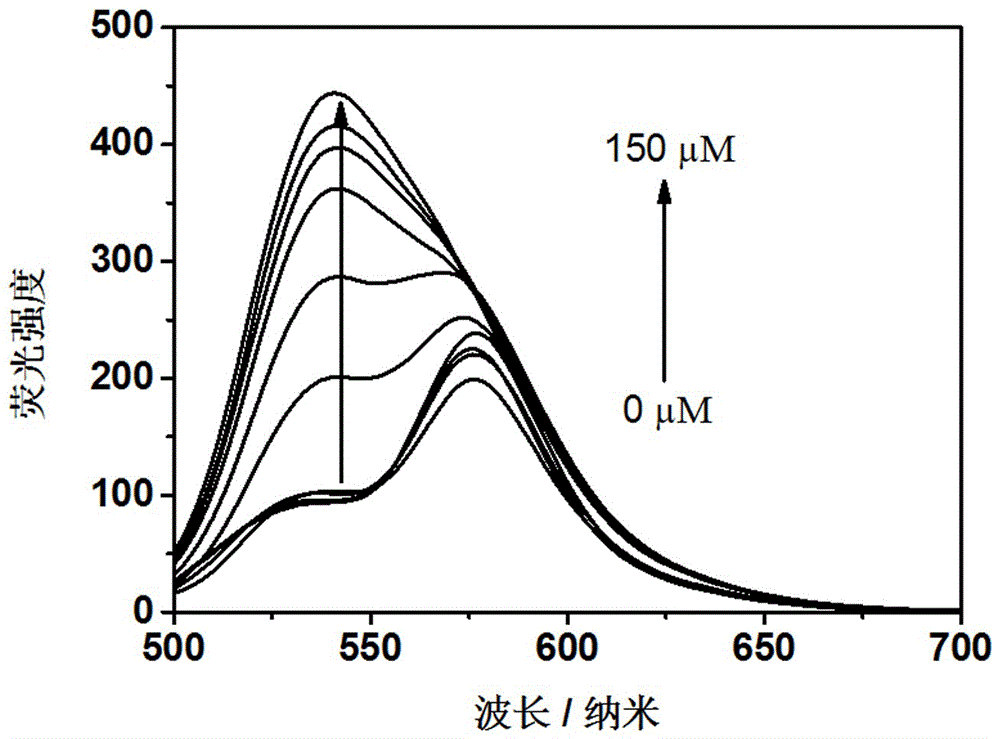Polymer nanoparticles capable of detecting hypochlorous acid and copper ions as well as preparation method and application of polymer nanoparticles
A technology for detecting hypochlorous acid and nanoparticles, applied in the fields of analytical chemistry, life science and environmental science, can solve the problems of inability to realize detection, complex detection process, single detection method, etc., and achieve excellent FRET related ratio detection effect and detection results. Precise, minimal instrument disturbance results
- Summary
- Abstract
- Description
- Claims
- Application Information
AI Technical Summary
Problems solved by technology
Method used
Image
Examples
Embodiment 1
[0034] A kind of polymer nanoparticle preparation that can detect hypochlorous acid and copper ion, comprises the following steps:
[0035] (1) Preparation of product 1.
[0036] Dissolve PEO-TTC (0.2 mmol), styrene (36 mmol), AEMH (4 mmol) and azobisisobutyronitrile (0.057 mmol) in 4 mL of 1,4-dioxane, ice bath condition Under vacuum and nitrogen cycle three times. The temperature was raised to 90°C for 4 h. After the reaction was completed, it was precipitated with an appropriate amount of diethyl ether (30 mL), centrifuged, and dried in vacuo to obtain the desired product 1.
[0037] (2) Using the product prepared in step (1) and rhodamine B isothiocyanate to synthesize product 2.
[0038] Dissolve the product 1 (0.03 mmol) synthesized in step (1) and rhodamine B isothiocyanate (0.054 mmol) in DMF (5 mL), and place the mixed solution in the dark under N 2 Stir at room temperature for 24 h under protected conditions. After the reaction, most (85-95%) of DMF was removed by...
Embodiment 2
[0042] A kind of polymer nanoparticle preparation that can detect hypochlorous acid and copper ion, comprises the following steps:
[0043] (1) Preparation of product 1.
[0044] Dissolve PEO-TTC (0.2 mmol), styrene (34 mmol), AEMH (6 mmol) and azobisisobutyronitrile (0.057 mmol) in 4 mL of 1,4-dioxane, ice bath condition Under vacuum and nitrogen cycle three times. The temperature was raised to 90°C for 4 h. After the reaction was completed, it was precipitated with an appropriate amount of diethyl ether (30 mL), centrifuged, and dried in vacuo to obtain the desired product 1.
[0045] (2) Using the product prepared in step (1) and rhodamine B isothiocyanate to synthesize product 2.
[0046] Dissolve the product 1 (0.03 mmol) synthesized in step (1) and rhodamine B isothiocyanate (0.054 mmol) in DMF (5 mL), and place the mixed solution in the dark under N 2 Stir at room temperature for 24 h under protected conditions. After the reaction, most (85-95%) of DMF was removed by...
Embodiment 3
[0050] A kind of polymer nanoparticle preparation that can detect hypochlorous acid and copper ion, comprises the following steps:
[0051] (1) Preparation of product 1.
[0052] Dissolve PEO-TTC (0.2 mmol), styrene (38 mmol), AEMH (2 mmol) and azobisisobutyronitrile (0.057 mmol) in 4 mL of 1,4-dioxane, ice bath condition Under vacuum and nitrogen cycle three times. The temperature was raised to 90°C for 4 h. After the reaction, it was precipitated with an appropriate amount of diethyl ether (20 mL), centrifuged, and dried in vacuum to obtain the desired product 1.
[0053] (2) Using the product prepared in step (1) and rhodamine B isothiocyanate to synthesize product 2.
[0054] Dissolve the product 1 (0.03 mmol) synthesized in step (1) and rhodamine B isothiocyanate (0.054 mmol) in DMF (5 mL), and place the mixed solution in the dark and N 2 Stir at room temperature for 24 h under protected conditions. After the reaction, most (85-95%) of DMF was removed by rotary evapora...
PUM
 Login to View More
Login to View More Abstract
Description
Claims
Application Information
 Login to View More
Login to View More - R&D
- Intellectual Property
- Life Sciences
- Materials
- Tech Scout
- Unparalleled Data Quality
- Higher Quality Content
- 60% Fewer Hallucinations
Browse by: Latest US Patents, China's latest patents, Technical Efficacy Thesaurus, Application Domain, Technology Topic, Popular Technical Reports.
© 2025 PatSnap. All rights reserved.Legal|Privacy policy|Modern Slavery Act Transparency Statement|Sitemap|About US| Contact US: help@patsnap.com



